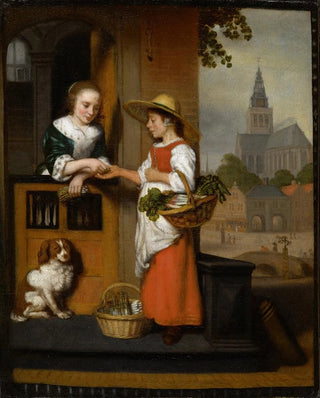Art print | Vegetable vendor - Nicolaes Maes


View from behind

Frame (optional)
In the fascinating world of 17th-century Dutch art, the artwork "Vegetable Vendor" by Nicolaes Maes stands out for its striking depiction of everyday life. This painting, imbued with realism and sensitivity, immerses us in the lively markets of Amsterdam, where vibrant colors and rich textures of vegetables transport us to a lively and authentic scene. The artist, capturing the present moment, invites us to observe not only the produce of the earth but also the human interactions that accompany them. Light plays a crucial role in this piece, illuminating faces and objects with a softness that evokes the warmth of sunny days.
Style and uniqueness of the artwork
Nicolaes Maes's style is characterized by meticulous realism and particular attention to detail. In "Vegetable Vendor," every element is carefully arranged, from the vegetables to the expressions of the characters. The artist uses a palette of earthy colors that enhances the authenticity of the scene, while creating a warm and welcoming atmosphere. Shadows and lights, skillfully worked, bring life to the forms, and the composition demonstrates a harmonious balance. This painting stands out for its ability to transcend the simple genre of portrait or still life, incorporating subtle storytelling that evokes the daily life of ordinary people. The presence of the vendor, with his engaging gaze, creates a direct connection with the viewer, placing them at the heart of the action.
The artist and his influence
Nicolaes Maes, a pupil of Rembrandt, mastered his master's techniques while developing a distinctive style that is recognizable. His career, marked by a shift towards more intimate subjects and genre scenes, reflects a constant search for authenticity and emotional depth. Maes captured the essence of his era, reflecting the values and lifestyles of the Dutch bourgeoisie. His influence extends beyond his time, inspiring many artists who sought to explore themes of daily life and human interactions. By focusing on simple subjects, Maes manages to give a

Matte finish

View from behind

Frame (optional)
In the fascinating world of 17th-century Dutch art, the artwork "Vegetable Vendor" by Nicolaes Maes stands out for its striking depiction of everyday life. This painting, imbued with realism and sensitivity, immerses us in the lively markets of Amsterdam, where vibrant colors and rich textures of vegetables transport us to a lively and authentic scene. The artist, capturing the present moment, invites us to observe not only the produce of the earth but also the human interactions that accompany them. Light plays a crucial role in this piece, illuminating faces and objects with a softness that evokes the warmth of sunny days.
Style and uniqueness of the artwork
Nicolaes Maes's style is characterized by meticulous realism and particular attention to detail. In "Vegetable Vendor," every element is carefully arranged, from the vegetables to the expressions of the characters. The artist uses a palette of earthy colors that enhances the authenticity of the scene, while creating a warm and welcoming atmosphere. Shadows and lights, skillfully worked, bring life to the forms, and the composition demonstrates a harmonious balance. This painting stands out for its ability to transcend the simple genre of portrait or still life, incorporating subtle storytelling that evokes the daily life of ordinary people. The presence of the vendor, with his engaging gaze, creates a direct connection with the viewer, placing them at the heart of the action.
The artist and his influence
Nicolaes Maes, a pupil of Rembrandt, mastered his master's techniques while developing a distinctive style that is recognizable. His career, marked by a shift towards more intimate subjects and genre scenes, reflects a constant search for authenticity and emotional depth. Maes captured the essence of his era, reflecting the values and lifestyles of the Dutch bourgeoisie. His influence extends beyond his time, inspiring many artists who sought to explore themes of daily life and human interactions. By focusing on simple subjects, Maes manages to give a






